The post Top 10 Tapas Bars In Madrid appeared first on The Expeditioner Travel Site.
]]>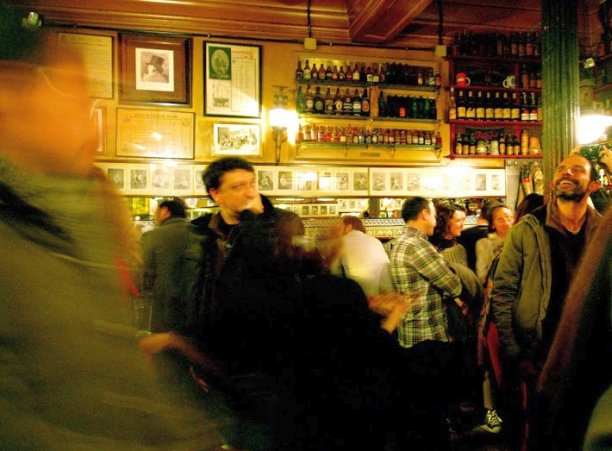
What goes into making a list like the top ten tapas bars in Madrid? Like any big city, it’s difficult to make a top ten for anything, let alone tapas. The below, with a couple of exceptions, reflects my personal bias for down-to-earth, affordable tapas (kind of the whole point, for me) served in venerable bars that have stood the test of time.
The old, the new and the regional — you’ll find a few places you may not have heard of, and those familiar with the city will note the absence of some legendary spots that have, in my opinion, become victims of their own success. Nevertheless, a visit to any the following will guarantee an unforgettable culinary experience with Spain’s national food.
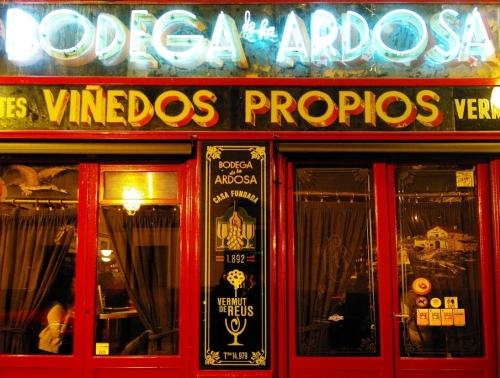
1) Bodega de la Ardosa
I didn’t get his name, but the bartender in La Bodega de la Ardosa is that bartender: he’s the guy in the bowtie who will quietly polish a glass as you pour your heart out over a vermouth. He probably doesn’t even want to speak to you but he looks like he could save your marriage with a casual aside. Everything about this place has a powerful nostalgia to it but nothing comes across as kitsch. Dimly lit, the walls are lined with old wines and beers and grotesque antique prints along with a host of novelties to keep the eyes busy.
Oh yes, the food. Not too much cooking going on here, but the canapé of goose liver paté with cranberries is not a canapé — it’s a mountain — and the empanada is especially good. They’re known for their salmorejo, a thick tomato soup laced with garlic and served chilled like its cousin, gazpacho. Although everything served here is simple and much of it cold, all is of the highest quality.
A joy and a delight, go for the vermouth; go back for everything else.
Bodega de la Ardosa: Calle Colon 13
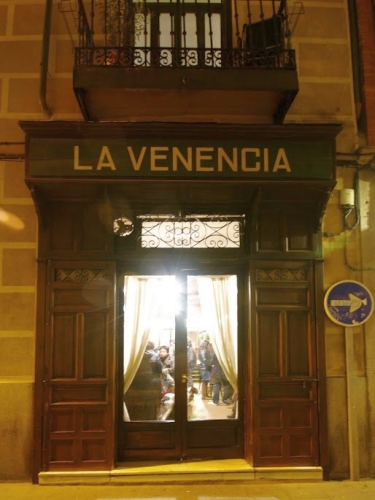
2) La Venencia
They don’t take kindly to photographers in La Venencia. According to the New York Times, it’s because the place was popular with Republican soldiers during Spain’s civil war and, photos being considered incriminating, the rule has never been relaxed. According to the owner I asked, they just find it annoying. Either way, it’s an irony because if ever there was a picture-perfect bar, it’s this one.
We’ve all seen old taverns. Even the ones that aren’t fake often lean on the “old” schtick a little too heavily, but this sherry house on Calle Echegarary in the centre of Madrid is the real thing: a genuine cultural artifact. No evidence whatsoever of any attempt to redecorate since Hemingway had his last manzanilla here. Sparsely furnished and every inch of the bare walls heavily discolored with time and tobacco, the famous wine from Jerez is served from the barrel in five dry varieties.
You won’t see a kitchen; they just slice things: cheese, jamón, mojama (cured tuna), chorizos and salchichones, all of it perfect with the wine. You might not even see a smile behind the bar and the ambiance is hushed, though when addressed, the gloomy looking owners turn out to be very gracious and proud of the place, and who could blame them? The high-ceilinged, humbly furnished taberna might just be the most beautiful bar I’ve ever seen.
La Venencia: Calle Echegarary 7
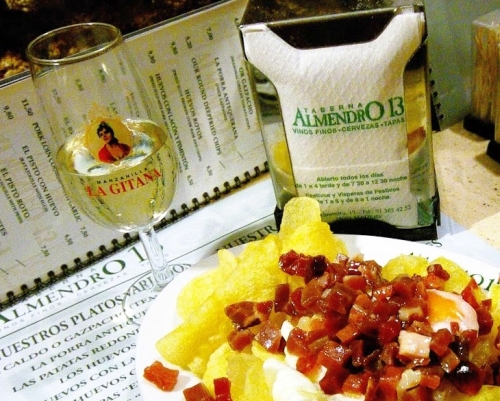
3) Almendro 13
A corner taberna on one of the quieter streets in La Latina, Madrid’s renowned tapa district, there is nothing quiet about Almendro 13. This place is so popular there isn’t even any room for a bar and therefore nothing to lean against with your drink. Everyone sits. If you can’t find a seat, and you probably can’t, you wait. My puppy dog eyes must still be in working order because they find us a couple of stools in the service area, downstairs in the cellar room.
Throughout our short meal we have to get out of the way or move a coat whenever the waiter wants another menu or place mat, but when our food arrives we know it’s been worth it: huevos rotos, a real madrileño dish and one that couldn’t be simpler. It consists of piles of wafer thin potato fries with a soft-boiled egg broken over them, topped with a heap of jamón taquitos (tasty little cubes of cured Spanish ham) — perfect with a glass of manzanilla on a tiny stool with a waiter leaning over you. The place is informal, friendly and a bustling Madrid highlight.
Almendro 13: Calle Almendro, 13
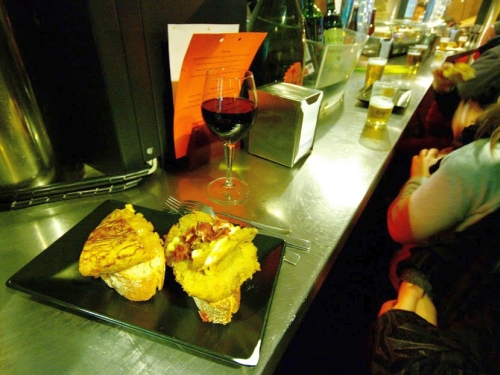
4) Restaurante Txirimiri
In centrally located neighborhood of La Latina, Restaurante Txirimiri is a relatively new addition to the tapas scene. At the center of Spain, Madrid is a city where all of the regional cuisines are showcased: Andalucia, Asturia, Valencia — you name it. In Txirimiri’s case, it’s Basque food in the form of pinxtos — elaborate little snacks piled onto slices of bread. Well, some of them are elaborate — one of the nicest ones here is a simple slice of tortilla de patata, all gooey runniness and caramelized onion. Another is the pinxto of breaded mushrooms with jamón. There is a dining room at the back and a sit-down menu of quality beef, fish, ibericos and something called Bull’s Tail Bikini — a reason to go back if ever there was one.
Restaurante Txirimiri: Calle del Humilladero 6
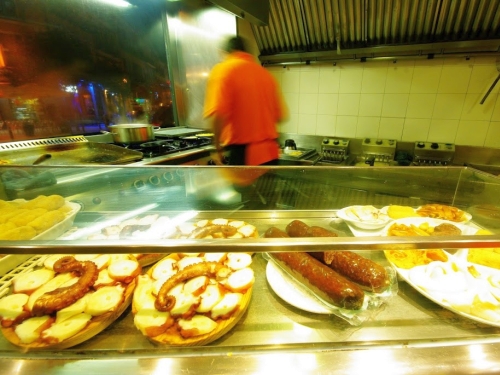
5) Las Bravas
The overall impression is that of day-glo orange — it’s the colour of the polo shirts the staff (all men of a certain age who look as if they’ve really lived) wear and of the sauce they douse the potatoes with. The color is impossible to miss because the place is lit up like a fish and chip shop. The ambience is more takeaway than bar, but bar it is; the floor strewn with discarded paper napkins and the roar of the customers deafening.
Patatas Bravas is eaten all over the country and is one of the few Spanish dishes that has real spice to it, but it isn’t just any old version that they serve at Las Bravas. Oh no, these people claim to have invented it, sometime back in the fifties, and there’s a patent on their product to back their claim up.
They cook in a window overlooking the street in the Espoz y Mina branch (there are three outlets within a few streets of each other), so all is well on the hygiene front, apart from the floor. You can also have morcilla (blood sausage) or pulpo (octopus), but in a Catholic country, coming here and not trying the patatas is probably some kind of sin.
Las Bravas: Calle Espoz y Mina, 13 and two more branches nearby.
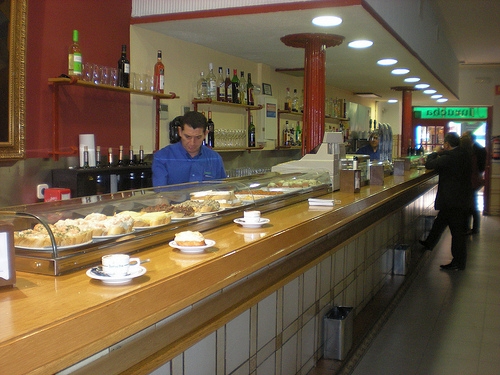
6) Jurucha
Jurucha has been opening its doors at 19, Calle Ayala, in Madrid’s upscale Salamanca district since 1961. That’s a long time, but it’s only going to take you a couple of seconds to decide whether you like the place or not. Not at all upscale, this is exactly the kind of Spanish bar that will have some of you turning around in the doorway, and no bad thing — at least the rest of us will have a tiny bit more room to squeeze into this long, crammed and uproariously noisy space. If none of this sounds appealing, don’t even bother, but if a bar that knows what it’s doing and does it well sounds good to you, don’t miss Jurucha. Quality ingredients and simple canapés prevail with an unexpected menu highlight I haven’t seen elsewhere: a hard-boiled egg croqueta.
Jurucha: Calle Ayala 19
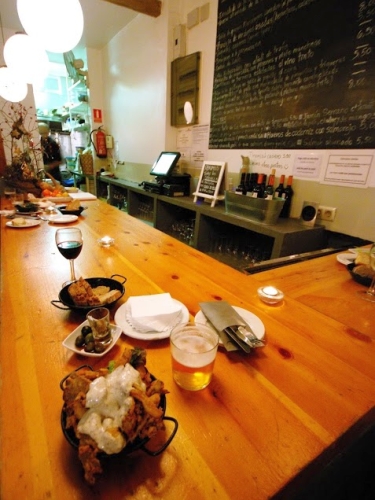
7) Baco y Beto
In the lively and gay-friendly Chueca area, Baco y Beto is another relative newcomer. The interior is sharp and there’s just enough light to get a good look at your food. Just as well because this is some good looking food. Presentation is important to the owners here; even your cutlery arrives in a neat little silver paper envelope.
With raciones averaging at around the €11 mark and medias at around €6.50, lingering here will cost you a little more than it would in an old-school tapas joint, and aficionados of the traditional tapa scrum might find the atmosphere a little subdued. However, with interesting selections like breaded mushrooms in a truffle alioli and shredded lamb on a caramelized plantain cake on offer, Baco y Beta is a must-try for the foodies.
Baco y Beto: Calle Pelayo 24
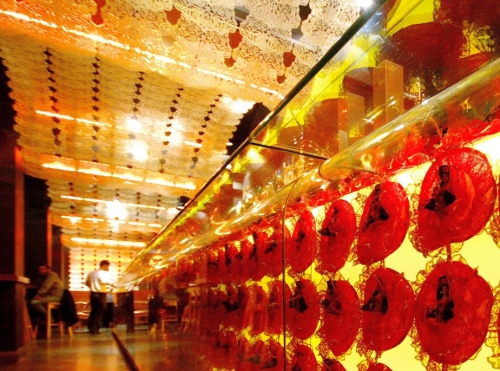
8) Estado Puro
The brainchild of chef Paco Roncero, Estado Puro is on a mission to share the traditional flavors of the Spanish tapas in new and exciting ways. Old favorites emerge from an avante garde kitchen in surprising forms: ensaladilla rusa, patatas ali oli, croquetas de jamón and so on.
The first treat here though is visual. On Plaza Cánovas del Castillo and in a new branch on Plaza del Angel in the Huertas district, the bars are decked out in post-kitsch fabulousness. In Angel, plastic bailaora dolls stud the front of a bar that stretches away into a clattering orange take on the flamenco aesthetic. Estado Puro is all about celebrating Spanishness by reinventing it.
It would be a very strange tapas joint indeed that couldn’t put a tortilla de patatas in front of its customers and Estado Puro is no exception. What is exceptional is the twist: their “21st Century Tortilla” comes in a glass. The trio of traditional tortilla elements are served up in a creamy, comforting concoction that replicates the flavors of the famous Spanish omelette in liquid form.
Estado Puro: Plaza Cánovas del Castillo, 4
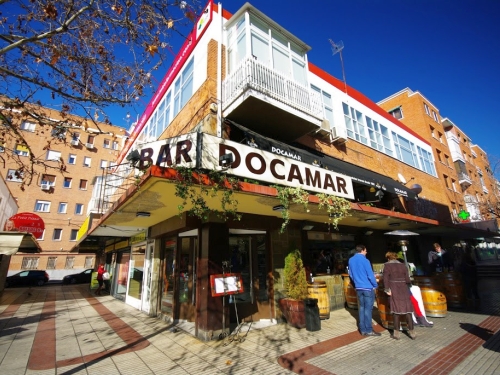
9) Docamar
Docamar is slightly outside the center of Madrid, making it more of a neighborhood place, but still very reachable by bus or leisurely walk. Its appearance on this list makes patatas bravas the dish of the day because, as it is in Las Bravas, that’s the speciality here. It’s further down in the ranking because it doesn’t quite have the pedigree of its more central rival but there isn’t much between the two bars in terms of flavor — the truth is the potatoes are fried well in both and the bright orange, spicy sauce is very similar. Docamar will throw you a few for free when you order a drink, and with seating areas upstairs and down probably provides the more comfortable experience. My advice? Patatas bravas are always a good idea — so go with both.
Docamar: Alcalá, 337
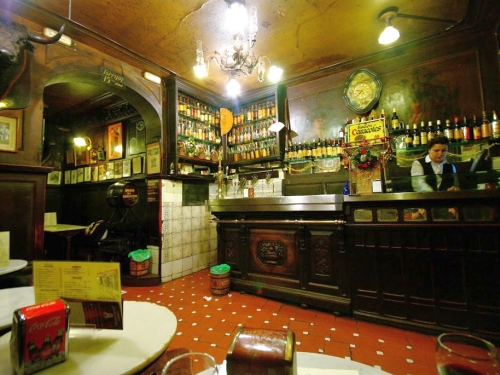
10) Taberna Antonio Sánchez
Maybe I’m too easily seduced by the antique, but Taberna Antonio Sánchez is my kind of bar. Hidden away in the gritty Lavapiés neighbourhood near the city center, everything from the façade out front to the dining room at the back speaks of a bygone age. I’m sure the kitchen is spotlessly clean these days but the owners have been careful to leave a layer of dust over the shelves of sherry bottles and bull’s heads (the bar is named for the original owner’s son, who died in a bullfight).
It’s the oldest in central Madrid, having opened in 1830, but the food is fresh and they specialise in snails, fried eggs, tripe and Olla Gitana, a gypsy stew.
Taberna Antonio Sánchez: Calle de Mesón des Paredes 13
By Robin Graham

ABOUT THE AUTHOR
 Robin Graham has written for In Madrid, The Expeditioner and the Matador Network. He regularly contributes to The Spain Scoop and blogs at the award-winning Alotofwind. Follow him on Twitter: @robinjgraham.
Robin Graham has written for In Madrid, The Expeditioner and the Matador Network. He regularly contributes to The Spain Scoop and blogs at the award-winning Alotofwind. Follow him on Twitter: @robinjgraham.
The post Top 10 Tapas Bars In Madrid appeared first on The Expeditioner Travel Site.
]]>The post In Search Of The Other Spain In Asturias appeared first on The Expeditioner Travel Site.
]]>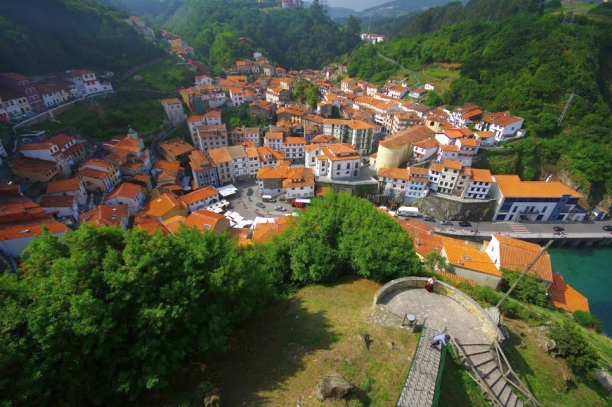
Spain is a well-oiled tourism machine. In addition to the coastal resorts that established themselves in the ‘60s and ‘70s and any number of tomato-pelting, bull-running festivals made famous by Hemingway and the like, Spanish tourism nowadays seeks to cater to the visitor on the lookout for culture, for history, for sport, for spiritual retreats and food odysseys, riding, hiking climbing and skiing, painting and writing, winetasting and walking.
It has got it all, in other words. Not surprisingly, perhaps, for a country mired in its own economic woes, modern Spain seeks to be everything to everyone. Can it have its Tarta de Santiago and eat it though? Can the country that attracts more visitors than just about anywhere else in the world accommodate that trickiest of customers: the visitor who doesn’t like other visitors? This August, at the height of both domestic and international tourist season all over Spain, I got into a car at my home in the country’s southern tip with a notepad and camera in hand along wtih my fiancée, K, and we headed north to find out.
We had set ourselves a serious challenge: to find some quiet and solitude in a country that voluntarily fills itself to the rim with visitors every summer in an annual attempt to gorge itself on the tourist dollar by any and all means necessary. You name it: beaches, discos, golf resorts, castles, casinos, water parks, museums, markets, bodegas, brothels and bars. They pull out all the stops here, and we fully expected to have to work to find our peace and quiet.
It took about 20 minutes.
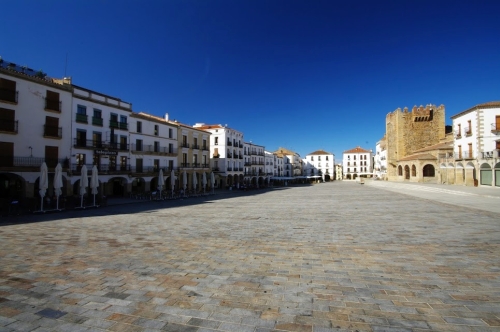
Very few things I’ve ever come across are as long, straight or empty as a Spanish road. This is a big country; the motorways that connect the southern coast with Seville and places like Mérida and Cáceres, an ancient town roughly 185 miles north of the bay of Cádiz, cut across open terrain, parched by the summer to a yellow dust and strewn with boulders and rickety olive groves. Huge skies towered overhead, and for long stretches, ours was the only car.
We stopped in Cáceres for a night to take a look at its famous old town, built largely on the wealth of those returning from a bit of plunder in the New World, but with roots going back to the Romans and beyond. It was hot and it was busy, but an early morning walk, even in August, furnished a quiet and undisturbed experience. As the sun rose over the towers and turrets, we unexpectedly had the place to ourselves.
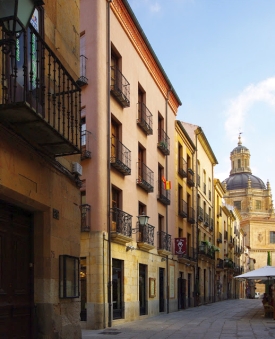
We spent the following few days on city breaks in Salamanca and León, enjoying architecture and bar life. It was the middle of August, and despite the fact that both were normally two bustling university towns, we were able to stroll unhurriedly through sparsely populated streets. We had the tower of Salamanca’s cathedral to ourselves and the whole of León’s wonderfully Gothic House of Light was ours as we sat in an empty square at night and enjoyed an illuminated and uninterrupted view.
That was it for cities. Continuing north, we headed for Asturias — beloved of the Spanish and largely unknown to the foreigner, and also the main focus of our trip. Asturias is a mountainous region that hugs the country’s north coast and defies just about any preconceived notion of Spain you might think of. There is no flamenco here. Cider is preferred to wine. The hillsides are a deep green and the cheese is blue.
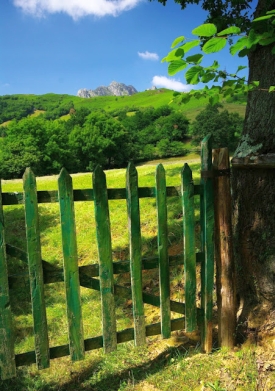
Ironically, the only region of old Spain never conquered and influenced by Arab invaders has become possibly the least recognizable as Spanish, at least in the stereotypical sense. We would end up on the coast — an important moment for us, having driven from its counterpart in the south with its views of Africa, to this fresher, cooler shore that faces in Ireland’s direction. We would feel some irritation in Cudillero, a lovely fishing village swamped with tourists on an August weekend, reduced to the status of parking lot and fridge-magnet emporium. We would swear never to travel in the summer vacation season again, if we could help it.
First, though, we would spend a few days in the region’s highlands. In the average Spanish mind, these mountains stand for many things. Milk and butter from the brown-eyed bovines that graze here, playing a pastoral melody on the hillsides with their tinkling bells. The famous cheese from Cabrales, also courtesy of the cows, but traditionally blended with sheep or goat cheese to give it a stronger flavor — it’s as good as Roquefort. Cidra, the natural cider made from Asturian apples. To let it breath, it’s poured from a bottle in one hand fully extended overhead to a glass held as low as possible in the other — quite a skill. It’s natural and unsweetened and goes down rather well (all in one go, according to tradition) with the cheese.
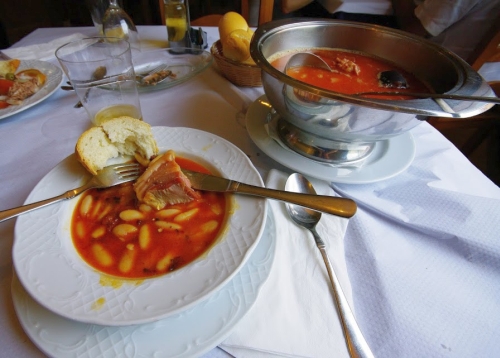
Perhaps more than anything else, the region stands for fabada asturiana, a legendary regional stew, available in any supermarket in the country, canned in a form that bears almost no resemblance to the home-cooked original. The main ingredients are large white beans, cured shoulder of pork (lacón), blood sausage (morcilla) and chorizo. If you can get through a massive Asturian portion, and if you can keep the foolish grin off your face while you’re at it, you’re a better man than me.
Asturias is a place to be outdoors. The summer here is warm but temperate enough to make walking or cycling comfortable. We hiked the Ruta de las Xanas (The Fairies’ Way), a well-known trail that begins just outside the town of Villanueva and ascends a deep gorge via precipitous pathways and rock tunnels. Navigating our way around a family of goats, we found ourselves in a little forest at the top, and beyond that an open, high valley where Casa Generosa, in the tiny hamlet of Pedroveya, serves a particularly recommended version of fabada. However, don’t try to go on Wednesday — it’s closed.
Down below in a long, deep valley, bicycles can be hired in the little town of Tuñon for the trip along the Senda del Oso (Path of the Bear), a route through the valley for around 12 astonishing miles along canyons and through more tunnels hewn through rock. This is bear country, and although notoriously elusive, if you want to see some you probably can. Paca and Tola, two orphan bears who live in semi-liberty just outside the town of Proaza, are fed daily at noon and you stand a good chance of spotting them when they come down from the mountain for their lunch.
We also walked the Valle del Lago, a 7 1/2-mile hike along gentle terrain that culminates at a beautiful glacial lake in the Somiedo Natural Park. Few stops on the trip brought it home so effectively that this is not the Spain of the brochures, of the package tours, Costa holidays and castanets. Think Switzerland. I’d seen images of the New Zealand wilderness that looked more like this than other parts of Spain do.
It wasn’t all walking. A moment that has stayed with us was the morning when we got no further than the wooden bench outside our chalet, high on a mountaintop overlooking the most beautifully located swimming pool I’ve ever seen in my life and the valley below. Across from us the first shaft of golden light from the rising sun illuminated the long, rocky ridge of El Angliru on the other side of the valley. Lower down the land was cultivated and crisscrossed with hedgerows. Streams adorned the slopes and beside them little huts and cottages pocked the mountainsides like crumbs in the folds of a sheet.
We just sat there, a cup of instant coffee each, and we didn’t say a thing. We couldn’t have imagined a beach a big hotel or a noisy family at that moment. The only sound was bells; an unhurried melody chimed out from some church in the valley below and, closer to hand, the tinkling of cowbells as the locals grazed.
Not one word. All we could do was look. Breathe in the air, try to get our heads around what we were looking at. Nobody in sight. All the space in the world, all the quiet. Peace. Asturias. Spain.
By Robin Graham

ABOUT THE AUTHOR
 Robin Graham has written for In Madrid, The Expeditioner and the Matador Network. He regularly contributes to The Spain Scoop and blogs at the award-winning Alotofwind. Follow him on Twitter: @robinjgraham.
Robin Graham has written for In Madrid, The Expeditioner and the Matador Network. He regularly contributes to The Spain Scoop and blogs at the award-winning Alotofwind. Follow him on Twitter: @robinjgraham.
The post In Search Of The Other Spain In Asturias appeared first on The Expeditioner Travel Site.
]]>The post Top 10 Bars In Seville appeared first on The Expeditioner Travel Site.
]]>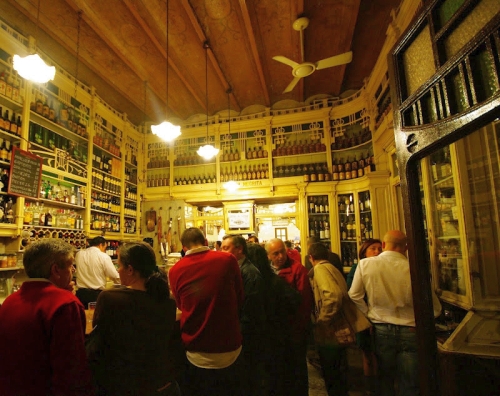
Seville is not a cheap city. On the other hand, it is the epicentre of tapa culture and cuisine. The tapas here aren’t free, as they are in Granada for example, but they are good — maybe the best that Spain has to offer. And it isn’t as if there isn’t any good value.
In the more generous establishments, three tapas (somewhere between five and ten euros, depending on choices) will easily feed two people. As the capital of Andalucia, the city offers more than just tapas of course, and a couple of the bars listed here are not food destinations, they’re just great bars. So next time you’re in Seville, make sure to visit one or all of these 10 great bars in the city.
1) Los Coloniales
Los Coloniales can’t be beaten. If you want a table, leave your name and wait. Eventually, you’ll get a table. If you want to do it properly, find yourself a square inch of bar space and scream for service over the roar. A waiter will roar back at you and then bring you something very nice and much larger than you expected.
The solomillo (pork tenderloin) al whisky is famous and the solomillo al oporto is better. The tablas — thick, toasted bread slices with salmorejo and jamon — are topped with quails eggs and draw crowds. Does dressed carrot sound exciting to you? They make it exciting here. When it comes you may have to hold it in your hand or balance it on the head of a nearby child (did I mention it gets busy?)
Plaza Cristo de Burgos, 19
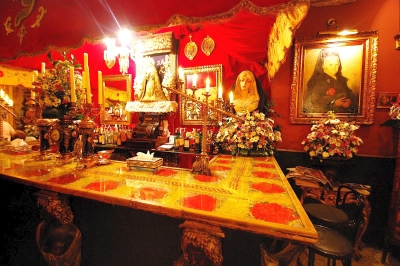 2) Bar Garlochi
2) Bar Garlochi
They only serve drinks, but that’s not a problem here. Tucked into a side street near Plaza Alfalfa, there isn’t a tapa in sight and just as well: eating would be strange with the reek of incense that hangs in the air. Every item of décor is salvaged church tat. Brass candleholders and funereal flower arrangements abound, as do portraits of saints and devout sevillanos. You can’t even get a glass of red wine, just cocktails, shots and beer. What you do get is the campest barroom experience in Seville, and all under the watchful eye of the Virgin. Its score on the atmosphere front isn’t exactly hurt when a bunch of women at the bar burst spontaneously into flamenco. They don’t look like they quite know what they’re doing, but still.
Calle de los Boteros, 26
3) La Trastienda
This place isn’t pretty. I call it the chipper on account of its fluorescent-lit similarity to a British fish & chip shop. The duck liver is so tender it melts if you look at it, the gambas they serve are the size of a baby’s arm and the imperial anchovies are almost as big. The owner here cares: He keeps his eye on the door to see who comes in and will probably be watching as you take your first bite. His co-workers are friendly and up for a chat. Maybe they think they have to try harder because they’re surrounded by more famous places, but popping in to La Trastienda is all about warmth and welcome . . . and duck liver.
Plaza de la Alfalfa, 8
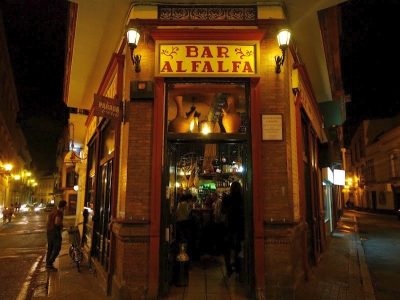 4) Bar Alfalfa
4) Bar Alfalfa
Just next door to La Trasteiandea, Bar Alfalfa is a tiny and beautiful corner bar with standing-room only, and there is, of all things, an Italian twist to the tapas. The caprese is made with good buffalo mozzarella and dressed with oregano rather than basil, just to keep things Spanish.
A member of the staff may well ask you to move aside so that they can scale a ladder and fetch a bottle of wine, such is the premium on storage space here. There’s an important difference between being crammed and being cosy though, and Alfalfa is definitely the latter. Just next to Plaza Alfalfa and a neighborhood favorite, it attracts a young crowd and is always lively.
Calle Candilejo, 1
5) Bodega Santa Cruz
Right on the main tapa drag in Santa Cruz, and just up the street from the cathedral, there’s some debate about whether this place — also known as Las Columnas because of the pillars out front — is more beloved among the locals or among foreign students and tourists. In fact, if you take a look around, there’s plenty of both. Well established, this is old-school Spain; your account will be totted up in chalk on the bar in front of you just as it is in La Trastienda. Arrive at a busy time and you may have to enjoy your drink and tapa outside. If so, I’ve no idea how they keep track of your spending, but they do. A popular spot for espinaca con garbanzos, but for my money the espinaca con queso is even better.
Calle Rodrigo Caro, 1
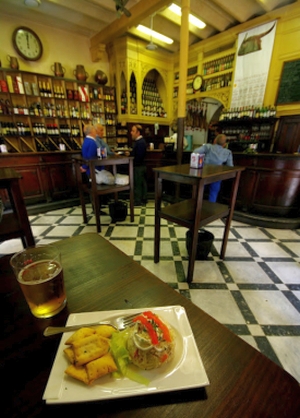 6) Casa Morales
6) Casa Morales
Whatever your position on bullfighting, the bull ring in Seville is a great place to be near if you’re hungry. Casa Morales, or Bar Hijos de E. Morales as it says over the door, provides another fix of old-school charisma. The back room is packed with enormous tinajas (stoneware sherry barrels) and the front room is lined with wine bottles and wood panel. The staff here wear pressed shirts and waistcoats and know what they’re doing. I try the salchichas al vino blanco and a little ensaladilla rusa. Both are excellent; brittle little potato chips soak up the white wine while I soak up the antique ambience.
Calle Garcia de Vinuesa, 11
7) El Rinconcillo
These guys set up shop back in 1670 so you’d expect them to know a thing or two about running a bar by now, and indeed, they do seem to have gotten the hang of it. Let’s be honest, when you’re in a place this old and this ridiculously charming, it doesn’t really matter whether the tapas are any good or not. Fortunately, they’re not bad at all. They keep it simple here, serving up the reliable classics. Espinaca con garbanzos is ubiquitous in Seville and this is the place to try it; it seems a bit spicier and a lot tastier. The kind of place where one finds oneself looking around a lot, especially at the walls, wondering how many hundreds of years old that thing is.
Calle Gerona, 40
8) Casa Roman
How does one write a review of Casa Roman without using the word “institution”? Oops. People come here for the jamón de Jabugo that hangs overhead. I order the fried cod, and it’s fantastic. The bar fronts out onto the beautiful little Plaza de los Venerables, which is served by several other bars as well so when you’re all pigged out on jamón and fancy something else you don’t have far to go. One of them, Hostería del Laurel, is number eleven on this top ten list.
Plaza Venerables 1
9) La Flor de Mi Viña
Right in the middle of the shopping district, this is a real Saturday afternoon stop-in. Most of the shoppers fleeing the crush of Calles Tetuan and Sierpes don’t get this far. They turn in at bar Blanco Cerillo on the same street, which is famous for its fish. In fairness, you can smell why, but it’s well worth the few more steps that take you to this wonderful little bar with its excellent range and very warm service. I have some beautiful riñones (pork kidneys) and a glass of manzanilla wine from Sanlucar de Barrameda. It certainly beats shopping.
Calle Jose de Velilla, 7
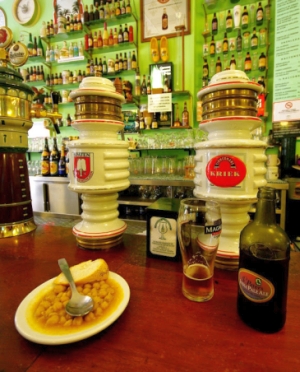 10) Cerveceria Internacional
10) Cerveceria Internacional
Ok, it’s seven bars since you found yourself in a tapa-free zone. Cerveceria Internacional isn’t tapa-free in fact, but it might as well be: People who come here come for the beer. I didn’t count (bad reporter!), but there are probably over 100 different types on sale; a good selection on tap and an incredible range by the bottle. Since they’ve run out of O’Hara’s Red Ale (damn!) I go for a pale ale from the wonderful St Peter’s brewery in Cornwall. Next time I’ll try the Domus, a craft beer from Toledo. For the hell of it I have some chickpeas too, infused with the flavour of flaked cod. Win win.
Calle Gamazo, 1
By Robin Graham

ABOUT THE AUTHOR
 Robin Graham has written for In Madrid, The Expeditioner and the Matador Network. He regularly contributes to The Spain Scoop and blogs at the award-winning Alotofwind. Follow him on Twitter: @robinjgraham.
Robin Graham has written for In Madrid, The Expeditioner and the Matador Network. He regularly contributes to The Spain Scoop and blogs at the award-winning Alotofwind. Follow him on Twitter: @robinjgraham.
The post Top 10 Bars In Seville appeared first on The Expeditioner Travel Site.
]]>The post Space, Time And Fez appeared first on The Expeditioner Travel Site.
]]>
He shrugged at me.
“It’s Berber silver, sir.”
“It isn’t though is it? Because it isn’t Berber, and it isn’t silver. Therefore, not Berber silver. Anyway, you didn’t mention the Berber bit when you sold it to me. I think the word you used at the time was ‘Sterling.’ I want my 200 dirham back.”
He smiled sweetly.
“Look, you lied to us and I want my money back. You can deal with me now or you can deal with me when I come back with the police. Up to you.”
I wasn’t sure if anything I’d said had had the slightest effect until I said the word police. He wasn’t smiling anymore.
“Sir, there is no problem, no problem . . .”
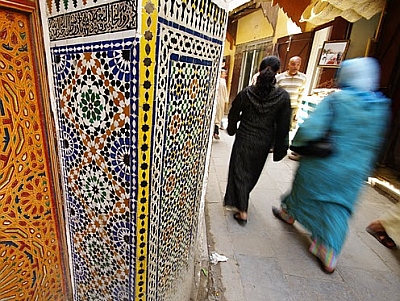 Walking back to our riad with the recovered dirham, we felt as triumphant as we had downcast the first time he fooled us. Dammit, we had been so careful not to get caught up in anything like this and in fact had had a very positive experience so far in the souks here in Fez, Morocco — very little of the hassle and pushiness we had been warned about so effusively by people who had never been here had materialized. Some polite enquiry, a bit of banter — nothing more. But there’s always one, isn’t there?
Walking back to our riad with the recovered dirham, we felt as triumphant as we had downcast the first time he fooled us. Dammit, we had been so careful not to get caught up in anything like this and in fact had had a very positive experience so far in the souks here in Fez, Morocco — very little of the hassle and pushiness we had been warned about so effusively by people who had never been here had materialized. Some polite enquiry, a bit of banter — nothing more. But there’s always one, isn’t there?
We had lists. My fiancée, K, wanted a leather bag, sandals, the aforementioned silver bracelet. I was after an antique print of the city if I could find one, a pair of Ray-Bans (questionable origin) and one of the little round, flat-topped hats that come from here and share the city’s name: Fez.
Not surprising, I suppose, to find a bad egg in amongst the crush of vendors that line this sloped, serpentine alley. Each shop is barely a hole in the wall — two meters wide if that — and the street is long; it leads all the way from Bab Boujloud, one of the old city gates, to the heart of the medina.
And in Fez, that’s a long way. The medina here is the largest intact medieval city in the Muslim world; home to over 200,000 inhabitants and around 9,400 streets, not a single one of them wide enough for four wheels. We find ourselves frequently hugging the walls to make way for charging beasts of burden or men with carts, or taking shelter in one of the shops and negotiating the verbal skills of yet another vendor, hard cases who sell their wares about two inches from your face — redefining your sense of personal space even as they overcharge you for the little mother-of-pearl inlaid box you never knew you wanted.
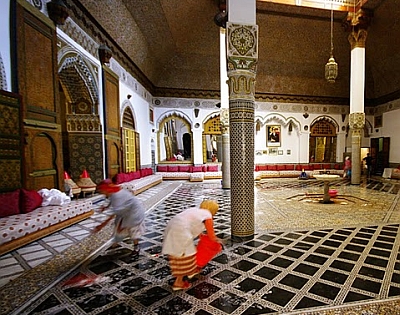 The tight squeeze, the sales pitches, the thousand and one smells and sounds, they all make the return to our tranquil courtyard a welcome one. Riads are usually restorations of typical bourgeois Islamic homes and follow a standard pattern. Very few — if any — windows face out onto the street. The Muslim home is instead turned inward and is built around a patio, usually with a water feature of some kind. Sunlight makes its way into the home through this inner sanctum — from above. Bedrooms and salons surround the patio on a number of levels.
The tight squeeze, the sales pitches, the thousand and one smells and sounds, they all make the return to our tranquil courtyard a welcome one. Riads are usually restorations of typical bourgeois Islamic homes and follow a standard pattern. Very few — if any — windows face out onto the street. The Muslim home is instead turned inward and is built around a patio, usually with a water feature of some kind. Sunlight makes its way into the home through this inner sanctum — from above. Bedrooms and salons surround the patio on a number of levels.
It’s the opposite in both feel and dimension of the streets outside, and in fact goes a long way to explaining those narrow lanes: space was prized here and hoarded in the home rather than squandered in squares, public parks or wide streets.
The visitor to Fez is at a disadvantage. Where the Muslim resident can escape for prayer, when we ventured out again we were restricted to the dizzying and at times panic-inducing crush of the souks. The city is home to several mosques — the Qaraouiyine Mosque, the Jamaa Andalous — that are major in terms of both importance and scale but you wouldn’t necessarily know it even if you were standing right outside; in this warren of alleys looking up reveals little more than a blue crack of sky. The presence of the mosques is betrayed only by peeking through the doors at the airy courtyards and ablution fountains — sky, billowing breezes, flowing water, space. A sacred and reserved place; this is as far as the non-muslim can go.
Though, we weren’t entirely without options when it came to escaping the mayhem. Attached to any self-respecting Mosque you’ll find a madrasa, or medersa as they are called here (an Islamic school). They tend to be tranquil spaces, and in Fez there are a number of historical and spectacularly beautiful examples. Best of all — the non-muslim may enter.
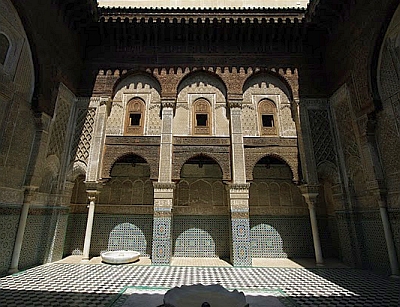 The Medersa Attarine was built between 1323 and 1325 and is a treasure of Andalusian-Moroccan art. If you have been to the Alhambra in Spain you will know what I’m talking about. Seeing this place has the effect of expanding one’s sense of Andalusian space. There is a little of medieval Spain here just as there is a lot of medieval Morocco in Spain. The place has a calming and uplifting effect and we lingered before heading to the Andalusian Quarter — the most ancient part of the medina — founded by refugees from the Reconquista in Spain.
The Medersa Attarine was built between 1323 and 1325 and is a treasure of Andalusian-Moroccan art. If you have been to the Alhambra in Spain you will know what I’m talking about. Seeing this place has the effect of expanding one’s sense of Andalusian space. There is a little of medieval Spain here just as there is a lot of medieval Morocco in Spain. The place has a calming and uplifting effect and we lingered before heading to the Andalusian Quarter — the most ancient part of the medina — founded by refugees from the Reconquista in Spain.
We made our way there using one of a number of colored walks — the blue one — that the city authorities have provided for the visitor. They aren’t always that easy to follow and getting lost in the medina is always just a corner away even with them, but they make a nonsense of the claim you will often hear that a guide is necessary to explore Fez.
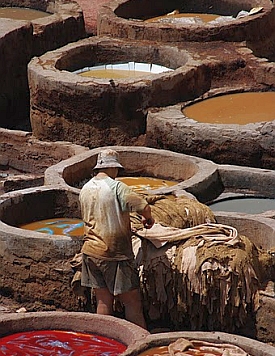 The walk took us past the Chouara tannery, a 14th-century construction of pools and basins used to dye camel, goat, sheep and cattle hide with indigo (blue), poppies (red), saffron (yellow) and henna amongst other materials. One of the largest open spaces in the city and an impressively timeless sight — it stinks to high heaven. We could observe the tannery workers from a terrace to which we were guided for a small tip; sprigs of mint thoughtfully provided to take the edge of the smell.
The walk took us past the Chouara tannery, a 14th-century construction of pools and basins used to dye camel, goat, sheep and cattle hide with indigo (blue), poppies (red), saffron (yellow) and henna amongst other materials. One of the largest open spaces in the city and an impressively timeless sight — it stinks to high heaven. We could observe the tannery workers from a terrace to which we were guided for a small tip; sprigs of mint thoughtfully provided to take the edge of the smell.
Across the river in the Andalusian Quarter we lost our way — several times, and not in a fun way. The day was a hot one and the souks here shabbier, the streets dirtier, the fake guides more insistent. When we finally found what we were here for — the Medersa Sahrij — we weren’t exactly thrilled to find it closed for restoration . . . for the next five years.
The mood switched when it became obvious that the attendant would be amenable to a little bribery. Payment made, he unlocked the massive wooden doors for us and warned that we will have to be quick. We stepped in and down into the sunken entrance; he unlocked an inner door of mashribiya (wooden lattice) and retreated.
This place had been high on my list and I had never expected that we would have it to ourselves. The medersa is named for the pool that takes up most of the courtyard and that was empty. A puddle at the bottom and a few weeds grew in and around it, sprouting up between deteriorated tiles. The whole place was unkempt and in disrepair and was without a doubt the most beautiful space I’d seen so far in Fez.
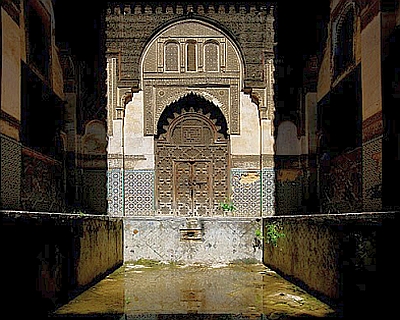 There was something about being there alone, on a clandestine visit and seeing the art and architecture in this state — pre-restoration — that made it a glimpse of something hidden. We felt much closer here to the people who had built it than we did in restored sites elsewhere. The distance between us and them was mapped out in the crumbling plasterwork and the sun-baked mashrabiya. I was looking at the original work and could touch with my hand what a 14th-century artisan had made with his.
There was something about being there alone, on a clandestine visit and seeing the art and architecture in this state — pre-restoration — that made it a glimpse of something hidden. We felt much closer here to the people who had built it than we did in restored sites elsewhere. The distance between us and them was mapped out in the crumbling plasterwork and the sun-baked mashrabiya. I was looking at the original work and could touch with my hand what a 14th-century artisan had made with his.
Back to the alleys. We followed another walk, or tried to. The green one, which is all about palaces and gardens apparently — but not for us. For us, it was about hunger. It didn’t seem to be particularly big on restaurants or cafes, that part of town, until we spotted a hole in the wall adjacent to one of the palaces highlighted in our guide.
There was nothing to distinguish the hole (a hatch in the wall, a few steps down, a bearded man frying an egg over a solitary hotplate) from someone’s kitchen except for a baffling sign overhead that announced tea and panoramic views from the terrace. We concluded that it must have been referring to the palace and I gestured to the man to ask him. He indicated that we should descend the few steps into the sunken opening. Like the gentleman I am I asked K to precede me.
“No, you first”
We were led through a narrow and bafflingly disused galley kitchen behind the hatch’s hotplate, up a slender flight of stairs at the back and into what appeared to be a small family living room, if a little over populated with tables. There were sliding doors at the rear and the view was indeed panoramic — over the medina with its minarets and the more distant hills crested by Merenid Tombs. It was the widest vista we had been presented with, the most enormous open area.
Storks and larger birds of prey hovered over the city as we surveyed the walls and the koranic script and photos of Mecca that hovered over us. This was not what it had looked like from out front. Neither was it our only elevated dining experience in Fez; just the previous evening we had eaten on one of the city’s many roof terraces, just beneath an ornate blue-green minaret, watching the pair of kestrels that nested in one of its cavities.
We were served up a simple potato omelette — the single item on offer — and when we went to leave, down the small stairs and through the tiny kitchen, we were prevented from doing so by the proprietor who was blocking the exit with his prayer mat. When he finished he stood, thanked us for waiting and accepted an improbably small amount of money for the meal.
We squeezed out though the hatch, back into the crush and rush of the claustrophobic souks, the wide open spaces of our discovery.
By Robin Graham

ABOUT THE AUTHOR
 Robin Graham has written for In Madrid, The Expeditioner and the Matador Network. He regularly contributes to The Spain Scoop and blogs at the award-winning Alotofwind. Follow him on Twitter: @robinjgraham.
Robin Graham has written for In Madrid, The Expeditioner and the Matador Network. He regularly contributes to The Spain Scoop and blogs at the award-winning Alotofwind. Follow him on Twitter: @robinjgraham.
The post Space, Time And Fez appeared first on The Expeditioner Travel Site.
]]>The post The Conquest Of Tarifa, Spain appeared first on The Expeditioner Travel Site.
]]>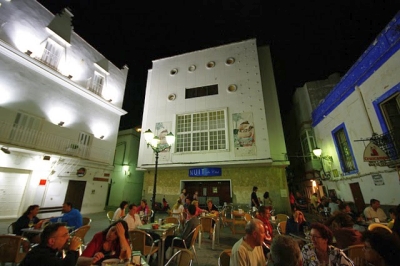
By Robin Graham
In the year 711, Tariq Ibn Ziyad — a Berber general — landed near the southern tip of Spain with 7,000 men, at the burning edge of the wildfire that was the Arab Empire — the House of Islam. In just a few years they were to conquer almost all of Spain, bringing much of the Iberian peninsula under Arab and Islamic rule for the next seven centuries and leading to the establishment of a Caliphate that would nurture a cultural milieu more diverse and sophisticated than the rest of Europe could hope to compete with until the blossoming of the Enlightenment, hundreds of years later.
None of which seems very important right now as I totter down Calle Nuestra Senora de la Luz and lurch into tiny San Hiscio square; I have had a few beers and I am very, very hungry. I take a table and ask the camarero to bring me some chocos, or cuttlefish, and another beer.
It is night and the sky is black, the buildings white, the air balmy. The old town is a maze of narrow cobbled streets and lanes, most of them on a slope. Wandering along one can peek though the Arab-style double doorways and catch a glimpse of the verdant, lovingly tended courtyards within. It brings to mind the famous pueblos blancos of the southern mountains, or the Albayzin in Granada, and exudes the ramshackle elegance that only an old Spanish town can deliver. This little square is an object lesson in the antique aesthetic of Andalusia, except for a beautiful modernist cinema I can’t help staring at.
Scholars tend to agree these days that the Arab conquest of Spain was a substantially peaceful affair, relatively speaking. Spaniards were already suffering plenty under the Visigoth yoke and were, in particular the Spanish Jews, perfectly open minded about the potential benefits of Arab rule. Just about anything was better than what they had and many of them intercepted the advancing Moorish army, not to fight them but to swell their ranks and lend a hand. Still, relatively speaking is the operative phrase; these were brutal times and one can imagine that there was a certain amount of fuss — pushing, shoving and yes, perhaps even some outbreaks of running and screaming.
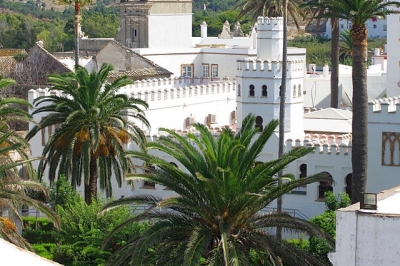 Not in this town though, I’ll wager. The reaction here would have been markedly different. Because — although the year 711 is held up so often, and so iconically, as the year the Moors came to Spain — these people had seen it all before. They were all screamed out. As the events of that year unfolded they might even have been spotted stifling their yawns because a year earlier, in the now largely forgotten 710, another Berber called Tarif Ibn Malluk had landed here with a force around 500 strong.
Not in this town though, I’ll wager. The reaction here would have been markedly different. Because — although the year 711 is held up so often, and so iconically, as the year the Moors came to Spain — these people had seen it all before. They were all screamed out. As the events of that year unfolded they might even have been spotted stifling their yawns because a year earlier, in the now largely forgotten 710, another Berber called Tarif Ibn Malluk had landed here with a force around 500 strong.
He was sent by Tariq to test the waters and having taken the town and sortied as far as Algeciras, encountering little or no resistance, he returned across the straits with booty and captives, convincing Ibn Ziyad that an invasion of the Iberian peninsula was within his reach. This place then was the litmus test. The Arabs named it the Isle of Tarif after the leader of the advance party and it bears his name to this day.
This is Tarifa.
The chocos are excellent. Cuttlefish, if you didn’t know, aren’t fish, they are closely related to squid and are served in all sorts of ways but I’m having them in a light batter, calamares-style. Indeed, anything that comes from the sea is good in Tarifa, unsurprising for a town that until around 25 years ago had been little more than a fishing village for centuries.
Its destiny has been inextricably tied to the sea since its Phoenician beginnings. The Arabs considered it the key to Spain, fortifying it to maintain their hold over the Straits. Its strategic position was the spur for the subsequent wrestling match between Christian and Moor that culminated in its final conquest by Sancho IV of Castile in 1292.
If the sea was the only factor governing Tarifa’s fate it might have remained a fishing village, but it isn’t. This is probably the windiest place on the continent, and Tarifa is renowned as Europe’s wind capital. It has two of them, for those that are interested: the Levante which comes from the east, and the Poniente from the west. It is this combination of wind and wave that led to the latest invasion in Tarifa’s long line of them, and to the siege which to this day maintains its grip on the town.
If strapping your feet to a board, your body to a kite, and launching yourself off Europe’s windiest coast seems like a stupid idea to you, then: a) you have a bright future ahead of you my friend; and, b) it probably won’t be in Tarifa. Tourism has become the town’s main source of income over the last 20 years or so but it is tourism of a very particular kind: a walk along the main commercial street throws up names like O’Neill, Quicksilver, Animal and Billabong alongside local brands Tarifa Pirates, Hot Stick and Cat Fun. Several surf clothing labels have been launched here in fact, later going national and even international.
Amidst the tapas bars and mesons that you would expect to find in an Andalusian town and that are, thank goodness, still here, you will find trendy chill-out joints — blue lit, branded, soundtracked with house and jazz and wi-fi enabled. For your breakfast, as well as a tostada or a croissant you can have muesli, fruit juices and smoothies, egg-white omelets and vegetarian, macrobiotic whatevers. In the summer months — all six of them — the troops that led this latest incursion are everywhere, the uniform a messy head of sun bleached hair, a nonchalant air, worn but meticulously selected surf clothing and a ridiculous, ridiculous tan.
Residents of nearby Algeciras — a salty port city — refer to Tarifa contemptuously as a tourist town and yet, unfairly, are just as dismissive of its quieter winter months — all one-and-a-half of them — when apparently, “there is nothing there.” Neither is true. It is a scene town, so far unspoiled by the altogether different trappings of uncontrolled, rampant tourism. You can find that on the Costa del Sol but not here, not yet. No lager louts, no vomit in the streets, no excruciating resort style entertainments.
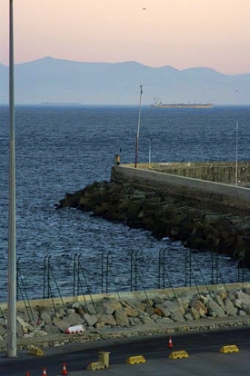 Where Tarif got as far as Algeciras, these new invaders sortie westwards, spreading out along the Atlantic (that’s another thing: situated as it is on the Straits, in Tarifa you can take a dip in the Mediterranean and, just minutes and a lazy stroll later, in the Atlantic). A number of beaches line up along this windswept coast. Long, white Los Lances with its fine sand is reserved for bathers in the busy months, kite and windsurfers off-season. Its northern stretch is unspoiled and is a bird sanctuary. Further on is Valdevaqueros, epicenter of all things kitesurf and described in a local guide, without a trace of irony, as for “cool people.” The championships are held here. It is in fact a fairly aggressive mess of boards, kites and people. I avoid it.
Where Tarif got as far as Algeciras, these new invaders sortie westwards, spreading out along the Atlantic (that’s another thing: situated as it is on the Straits, in Tarifa you can take a dip in the Mediterranean and, just minutes and a lazy stroll later, in the Atlantic). A number of beaches line up along this windswept coast. Long, white Los Lances with its fine sand is reserved for bathers in the busy months, kite and windsurfers off-season. Its northern stretch is unspoiled and is a bird sanctuary. Further on is Valdevaqueros, epicenter of all things kitesurf and described in a local guide, without a trace of irony, as for “cool people.” The championships are held here. It is in fact a fairly aggressive mess of boards, kites and people. I avoid it.
Past that the relatively sheltered coves of Punta Paloma, much more me, and further again the beaches of Bolonia, Los Alemanes and Atlanterra. In places the urbanization of the area is at an advanced stage but so far this costa, the Costa de la Luz between Tarifa and Cadiz, has escaped the ravages of its neighbor, the Costa Del Sol. Testament to this is the fact that the majority of visitors here are Spanish.
As for the charge that there is nothing to Tarifa in the winter months — when the chill-out bars and designer boutiques close their doors and the surf battalions pull out — what is left is exactly what I came here for: a quiet Spanish pueblo with a rich history, steeped in Moorish tradition, battered by winds on a starkly beautiful dramatic coastline and, crucially, peppered with tiny plazas and tinier tapas bars serving up the best food, for my money, in the world.
When the town is “deserted” I will still be able to wander down to my favorites. El Pasillo, for instance, or Caxala, and tuck into the media racion or tapa of my choice, or indulge in one of my favorite pastimes: bullying my girlfriend into trying various types of seafood she has no interest in.
They talk of Tarifa in the winter with dread. All that wind, no tourists and only the locals and their tapas bars left. I can’t wait. I am an invader too. I’m not going anywhere for the time being and it isn’t until I have made it through those months that my conquest of this little town will be complete.

ABOUT THE AUTHOR
 Robin Graham has written for In Madrid, The Expeditioner and the Matador Network. He regularly contributes to The Spain Scoop and blogs at the award-winning Alotofwind. Follow him on Twitter: @robinjgraham.
Robin Graham has written for In Madrid, The Expeditioner and the Matador Network. He regularly contributes to The Spain Scoop and blogs at the award-winning Alotofwind. Follow him on Twitter: @robinjgraham.
The post The Conquest Of Tarifa, Spain appeared first on The Expeditioner Travel Site.
]]>The post Deep Breath: The Alhambra At Night Is Worth The Hassle appeared first on The Expeditioner Travel Site.
]]>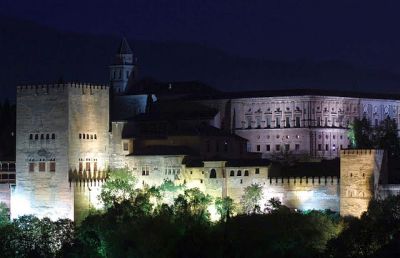
By Robin Graham
I bet Washington Irving didn’t have to put up with any of this.
Getting a ticket to visit that great treasure of Islamic art and culture, the Alhambra — made famous by Irving himself, among others — is no easy task. It isn’t that it’s hard to find; there’s a website for that — as easily navigated as was, I imagine, the 19th-century Spain that Irving, the great American essayist and historian, had to contend with.
No, it’s the decisions. It turns out that visiting the great Moorish citadel in Granada, one of Spain’s southernmost cities, is not as straightforward as you might think (or like). The choices are a little dizzying to the uninitiated. There are morning tickets and there are afternoon tickets, and within each, specific time slots for access to the complex of Nasrid palaces. There are three zones that make up the massive site — the palaces, the Alcazaba (the ramparts), and the Generalife (the summer palace). Seeing all three will easily take up the six hours your ticket is valid for. But where to start? And if you make the wrong decision here and miss your time slot at the palaces, will you be indulged as silly tourists are the world over and have your slot rearranged? No, you will not. You are a silly tourist and you will not be going to the palaces.
There’s more. Night visits are ticketed separately and limited to 90 minutes. Which will you choose: day or night? Both? Which first? How far in advance should you purchase your pre-booked (don’t tell me you didn’t pre-book) tickets? Will you collect them from the kiosk or from the machines? Which machines? There are day and night machines. Tickets must be redeemed with the card that was used to make the booking. Did we use your card or mine? Which card? What does that say? Is this thing working?
No, I’ll bet Irving didn’t. As I understand it, upon his arrival in the city and introductions with the local bigwig, he was simply shown to his room. In the Alhambra. I mean, come on! There’s a plaque now to mark the rooms where he stayed (for free) and wrote his book, “Tales of the Alhambra,” still on sale all over Granada.
We on the other hand find ourselves in a line at the ticket machines, the ones that were put here to eliminate the lines. We’re here for a night visit and only one of the night machines is working. To add to the mayhem, most of the people here who are attempting to use the machine have not bought in advance, and the machine is used exclusively to dispense pre-booked tickets. Everybody has to discover this on an individual basis, apparently, rather than just turn around and update everyone else.
The only thing that can make situations like this worse is when someone finally loses their temper and starts shouting, but this is Spain, so everyone is shouting. The staff member that turns up to weed out those who shouldn’t be here and to help the rest of us work the incomprehensible machine is shouting.
The only people not shouting are K and myself, and that is probably why we are repeatedly overlooked even when we get to the front of the line, in favor of those who shout and push from behind. Actually they aren’t really behind us anymore. As soon as we get to the front of it, the line inexplicably dissolves. It’s a mob now.
A snippet I’d read in my guidebook had said something about beauty, elegance and tranquility. I begin leafing through it to find the quote; I’ll use it as a calming mantra if this doesn’t end soon. When we finally get the staff member’s attention, almost alone with her now in the room, she says something in a thoroughly Andalucian accent that we barely understand.
“Yes,” I reply, “we have pre-booked”.
She is obviously from good stock because this revelation, leading as it does to the inescapable conclusion that she has been ignoring us for a full ten minutes, doesn’t even make her flinch. She takes the card we’ve been offering her for so long and hands it back with our tickets. We take them and wander off, seething, in the general direction of the palaces.
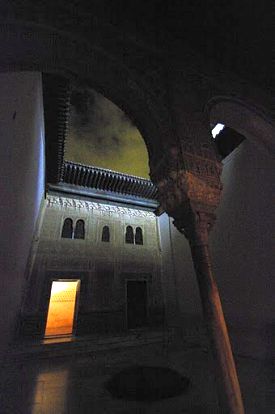 The big tease comes to an abrupt end the moment we step inside the hall of the Mexuar Palace, the oldest of three palaces that together comprise the royal residence. The Christian conquerors in the 15th century did their best to wreck this chamber, sealing up a ceiling lantern and installing a choir, but they didn’t remove the intricate tilework or the stunning oratory that faces Mecca at the rear.
The big tease comes to an abrupt end the moment we step inside the hall of the Mexuar Palace, the oldest of three palaces that together comprise the royal residence. The Christian conquerors in the 15th century did their best to wreck this chamber, sealing up a ceiling lantern and installing a choir, but they didn’t remove the intricate tilework or the stunning oratory that faces Mecca at the rear.
Our seething reduced to a simmer; we can hear the Court of the Myrtles before we see it — fountains babble at either end of this massive, mirror-smooth pool. The arched galleries on both sides are reflected in the water with architectural precision, the sense of proportion artfully doubled. A spotlight set on top of the Comares tower appears moonlike on the water.
An account here of the intricacies that adorn the chambers that surround the courtyard — the Hall of Ambassadors for example, or the Boat Room — wouldn’t do them justice. We take our sweet time, separating and meeting up again in the courtyard between wonders.
The third and newest of the palaces in the complex is the Palace of the Lions. Construction on it began in 1377, and its purpose was to house the royal harem. The palace is centered around the famous Courtyard of the Lions and is considered the crowning glory of the Nasrid style, an exuberant blend of Moorish and Christian influences.
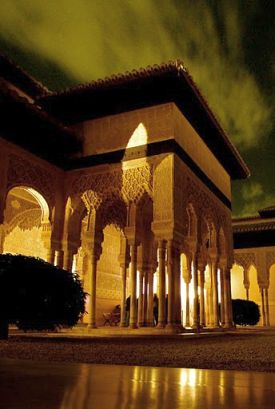 Even in the absence of the aforementioned lions (they’ve been whisked away for restoration), the moonlit courtyard casts a spell. It’s easily the most lavish in the complex, with its 124 marble columns and its elaborate cloisters and pavilions. The scale is still human though, and one can easily imagine the space inhabited by a family at rest or play.
Even in the absence of the aforementioned lions (they’ve been whisked away for restoration), the moonlit courtyard casts a spell. It’s easily the most lavish in the complex, with its 124 marble columns and its elaborate cloisters and pavilions. The scale is still human though, and one can easily imagine the space inhabited by a family at rest or play.
Four fantastically decorated halls surround the courtyard, with ceilings of muqarna (an ingenious Lego-like system of ceiling decoration which gives the impression of stalactites), central pools and the customary tiling. They tell their own stories, from the delightful Lindaraja Mirador where the sultan’s favorite concubine would have daydreamed, overlooking the city, to the Hall of the Abencerrajes, where 36 of the noble Abencerraje family were murdered because one of them had slept with her.
Ninety minutes later, and some of the most beautiful spaces — indoor and out — ever created by human hand have had their effect on us. We emerge from the citadel soothed and serene, onto the height that holds it aloft over the city which sprawls and twinkles below us.
It is 10 p.m., and around here that makes it tapeo time. Tapeo means tapas, and if you’re a fan of the bite-sized cuisine that is served in bars all over Spain, then Granada is the jackpot.
Tapas are free here — bartenders in this town wouldn’t think of serving you an alcoholic drink without feeding you as well. There are the usual tourist hotspots that will throw in some olives with your drinks, of course, but this is 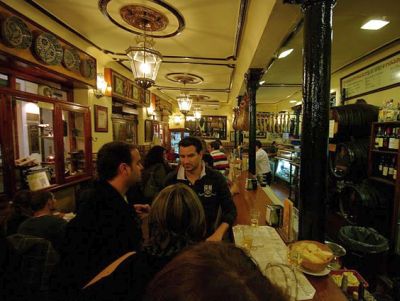 a Tapas town and you don’t have to look too hard for the real thing: noisy bars filled with Granadinos, chomping away on pescaito (battered fish fried in olive oil), berenjenas (deep-fried eggplant), gambas (shrimp) and a million other ridiculously tasty choices.
a Tapas town and you don’t have to look too hard for the real thing: noisy bars filled with Granadinos, chomping away on pescaito (battered fish fried in olive oil), berenjenas (deep-fried eggplant), gambas (shrimp) and a million other ridiculously tasty choices.
It’s where we want to be and we have choices about how to get there. We can wander down into the Realejo, the old Jewish quarter, and find the Campo del Principe — a popular and picturesque square lined with bars. We can stroll down the Cuesta de Gomérez to the Plaza Nueva and beyond, to the bars and tavernas of the Lower Albayzin, the old Moorish Quarter, or we can descend via the Cuesta de los Chinos to perhaps the city’s prettiest square, the Paseo de los Tristes, with its open-air terraces.
Somehow these decisions don’t seem as taxing or troublesome as the ones we had to make earlier. Wherever we end up we can sit with a glass of local wine in hand, cram our faces full of some of the world’s best bar food and, sparing a thought for that poor sap Washington Irving stuck up there on the hill, gaze back at the true wonder that we have just left behind.

IF YOU GO
Tickets for a night visit to the Nasrid Palaces cost €12 per person, or €13 if you book in advance from alhambra.org, which you are strongly advised to do. Even in the off-season, demand is high. Tickets booked in advance can be picked up at the ticket machines with the card used to make the booking (this way you will avoid lines (yeah right), or the possibility of not getting in at all).
If you are from the E.U. and are a senior citizen, you pay only €9, whether you book in advance or not, and children under the age of 12 are admitted for free, although you may prefer to take the little ones along on a day visit, when for the same ticket prices you will also be able to visit the Alcazaba (the ramparts) and the Generalife with its gardens, in addition to a time slot in the Nasrid palaces.
ABOUT THE AUTHOR
 Robin Graham has written for In Madrid, The Expeditioner and the Matador Network. He regularly contributes to The Spain Scoop and blogs at the award-winning Alotofwind. Follow him on Twitter: @robinjgraham.
Robin Graham has written for In Madrid, The Expeditioner and the Matador Network. He regularly contributes to The Spain Scoop and blogs at the award-winning Alotofwind. Follow him on Twitter: @robinjgraham.
The post Deep Breath: The Alhambra At Night Is Worth The Hassle appeared first on The Expeditioner Travel Site.
]]>The post Is It Possible To Eat Your Way Through Cairo In One Day? appeared first on The Expeditioner Travel Site.
]]>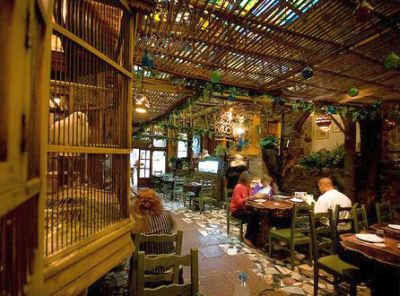
Egyptian cuisine is produced from the melting pot of the Middle East, North Africa and the Mediterranean. It is varied and fascinating, but if you only have one day in Cairo, you can cover the basics. Here’s how.
By Robin Graham
Breakfast
Felfela has been a fixture on the travel circuit in Cairo for not just years, but generations. A haven for those perhaps intimidated by the less polished eateries of the city, but still offering something of an Egyptian flavor, it has been a firm favorite for many. There are those who will tell you it’s past its prime and who knows, they may have a point, but its takeaway branch aimed at the locals, around the corner on Talaat Harb Street, is very definitely going strong.
I like to go for breakfast, sometimes tucking into it there and then, standing along the walls where pedestals have been placed for the purpose, otherwise returning with it to the hotel if I am staying nearby. As long as the doors are open, this place is busy.
Fuul is what I’m here for. Served in grainy Egyptian pita bread, fuul consists of cooked and mashed fava beans, often served cold. It is the quintessential Egyptian breakfast, more earthy and hearty than hummus, a better comparison being refried beans, but with a unique and not unpleasant bitterness. My friend “K” hates it instantly. I can’t get enough. Instead she has ta’amiya, the local equivalent of felafel, but greener, more moist and, well, better.
Lunch
Koshary is all wrong.
Served as fast food and pretty much Egypt’s national dish, it consists, bizarrely, of rice, macaroni and lentils. That’s right, you heard me. You wouldn’t credit it, would you? The sprinkling of a few fried onion flakes over the top with some chickpeas thrown in seems like a desultory effort at injecting a bit of flavor into this carb-fest; a little tomato sauce served on the side unlikely to elevate the whole stodgy mess to the status of decent meal. Insulting, almost.
 Until, that is, you take a mouthful. At which point what looked so wrong tastes . . . oh so right. There is alchemy at work here. It might be the Cairo air, thick with pollution, or perhaps the fluid, expert motion of the koshary men as they flick their metal bowls, combining the ingredients in the flash of an eye, almost unconsciously, their muscle-memory doing the work.
Until, that is, you take a mouthful. At which point what looked so wrong tastes . . . oh so right. There is alchemy at work here. It might be the Cairo air, thick with pollution, or perhaps the fluid, expert motion of the koshary men as they flick their metal bowls, combining the ingredients in the flash of an eye, almost unconsciously, their muscle-memory doing the work.
Whatever the extra ingredient, koshary is an extraordinary dish. The word originates in the Hindi kishri, meaning “an unlikely mix.” It commands devotion, allegiance and loyalty: Cairo’s outlets compete fiercely, and regulars are just as fierce in their defense of their preferred venue.
Many are the devotees of Abou Tarek restaurant — today, the burqa is a source of fascination for us there as we watch a young woman struggling to eat her koshary through it while eating there — but there are those who will swear by Koshary El-Tahrir near Tahrir square. Also, often overlooked, in the Bab El Louk district, there is a place called Lux where I had my first encounter with this staple. They have a few other branches around town.
When you sit down with your bowl, there will be a couple of dressing bottles on your table. The contents of one will be hot. The other will be a pungent mix of garlic, vinegar and lemon. Both will be unexpectedly delicious.
My “top ten things to do in Cairo” list is constantly evolving, but predictable suggestions such as the National Museum and the pyramids lost their slots years ago to experiences like taking a taxi ride (anywhere, just try it) and eating koshary.
It’s all wrong I tell you.
Dinner
Egypt, land of pharaohs, pyramids and pizza.
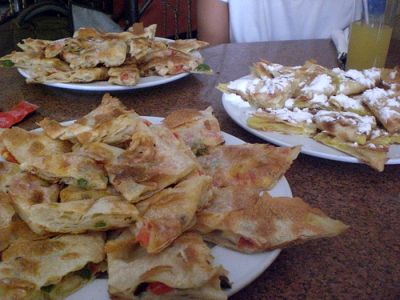 Well, almost. The fiteer is Egypt’s version of the slightly better known Italian flatbread. Like its cousin, it is street food, served in any number of down-to-earth places throughout the city. Unlike pizza, it’s made from lighter, flaky pastry and is usually stuffed rather than topped, though I’ve seen it both ways.
Well, almost. The fiteer is Egypt’s version of the slightly better known Italian flatbread. Like its cousin, it is street food, served in any number of down-to-earth places throughout the city. Unlike pizza, it’s made from lighter, flaky pastry and is usually stuffed rather than topped, though I’ve seen it both ways.
We are in Fatatri near Tahrir Square, a long-standing fiteer place. It’s our first evening in the city this time round, and I’ve dropped K in at the deep end, the place a dusty and rather grimy version of what it once was as the ubiquitous street cats circle our ankles for crumbs.
We are the only customers, not quite outnumbered by the three bored looking staff members. They have a wall mounted television on at full volume, Koranic readings thundering through the tiny restaurant. Something tells me I won’t be having any wine with my dinner. I don’t even ask, settling for a Fanta.
I have to hand it to them though, the fiteer is tasty, topped with spiced lamb and white cheese. These pancakes are as popular sweet as they are savory, filled with powder sugar, honey, nuts or coconut among a myriad of other options.
Still, I could have done with a drink.
Nightlife
Later, with that in mind, we find ourselves in the Al Hurriya cafe in the Bab El Louk area again, just across from Lux. This place, you might say, has seen better days. It’s one of those huge, echoing spaces, old-fashioned fans wobbling from the high ceilings; the 19th-century acoustics produce a clattering din. If anyone has approached the cafe with a can of paint over the last 50 years, they have evidently been turned away.
Tonight, Al Hurriya is crowded. We look around for a spare table to no avail, and the waiter helps us out by planting two rickety chairs at the end of one already occupied. Two bottles of Egyptian beer are plonked between us. Nobody has asked us what we want — it’s a given. It isn’t everywhere in Cairo you’ll be served beer and that’s why people come here. If you turn to the left when you come through the door it’s coffee, tea, dominoes and chess. If you turn right, it’s beer.
You might say it has seen better days, but you’d be wrong. The place is still an institution in Cairo, a meeting place for those on the political left, expats and the less conservative elements of Egyptian society. Cairenes don’t seem to care about chipped paint. We find ourselves sharing a table with Hassan and Abdul. They are in “shipping” and that’s as much detail as I’ll be getting on that.
End of day one — we have eaten well on the unpretentious food this city offers, and by sticking to the places where locals eat we have had a good taste of Cairo’s street life as well, its daily rhythms and its people.
Abdul looks over a a lady wearing the hijab at a distant table, soft drinks in front of her and her male and female companions.
“You know, before, you never see this,” he said, gesturing toward the small group. “No women in this place, never. Now, everything is mixed. A shame, really a shame.”
K is sitting right there.
“You really don’t like it mixed like this?,” I ask him.
“No, I don’t like. It’s a shame,” he repeats. “You like it?”
K is sitting right there.
“Yes, I prefer it mixed,” I say.
“So do I!”, he declares emphatically, breaking into a belly laugh, a large grin appearing on his face. “Shall we order more drinks? The night is young!”

Felfela, 15 Shara Hoda Sharaawi, Downtown, Cairo , 02/392-2833
These days Felfela has more than one branch but this is the original and the takeaway version is just around the corner on Talaat Harb Street.
Abou Tarek, No.16 on the corner of Maarouf and Shambliuan (Champlion), downtown.
They even have a website (with lots of annoying graphics). Learn all about Koshary at www.aboutarek.com
Koshary El-Tahrir, 12 Youssef El Gendy Street, Bab El Louk, 02-27958418.
Fatatri is on El Tahreir Street, near Tahrir Square.
Lux and Al Hurriya can be found on Midan Bab El Louk (Bab El Louk Square), Lux on the south side on El Tahreir St, and Al Houria on the north side on Abd El Salaam Areaf St.
 Robin Graham has written for In Madrid, The Expeditioner and the Matador Network. He regularly contributes to The Spain Scoop and blogs at the award-winning Alotofwind. Follow him on Twitter: @robinjgraham.
Robin Graham has written for In Madrid, The Expeditioner and the Matador Network. He regularly contributes to The Spain Scoop and blogs at the award-winning Alotofwind. Follow him on Twitter: @robinjgraham.
The post Is It Possible To Eat Your Way Through Cairo In One Day? appeared first on The Expeditioner Travel Site.
]]>